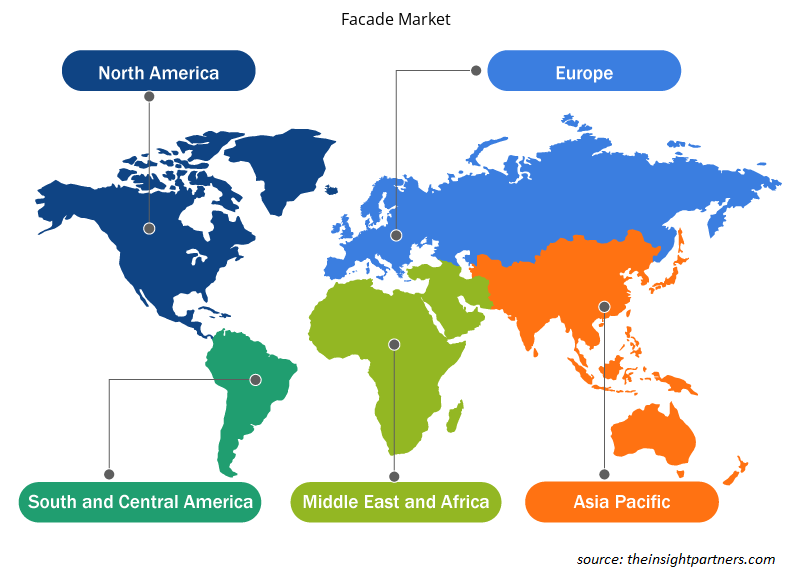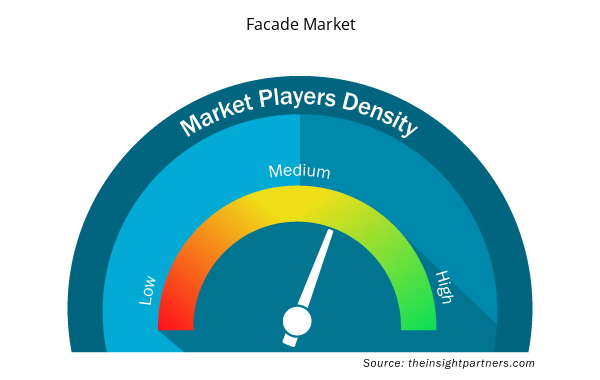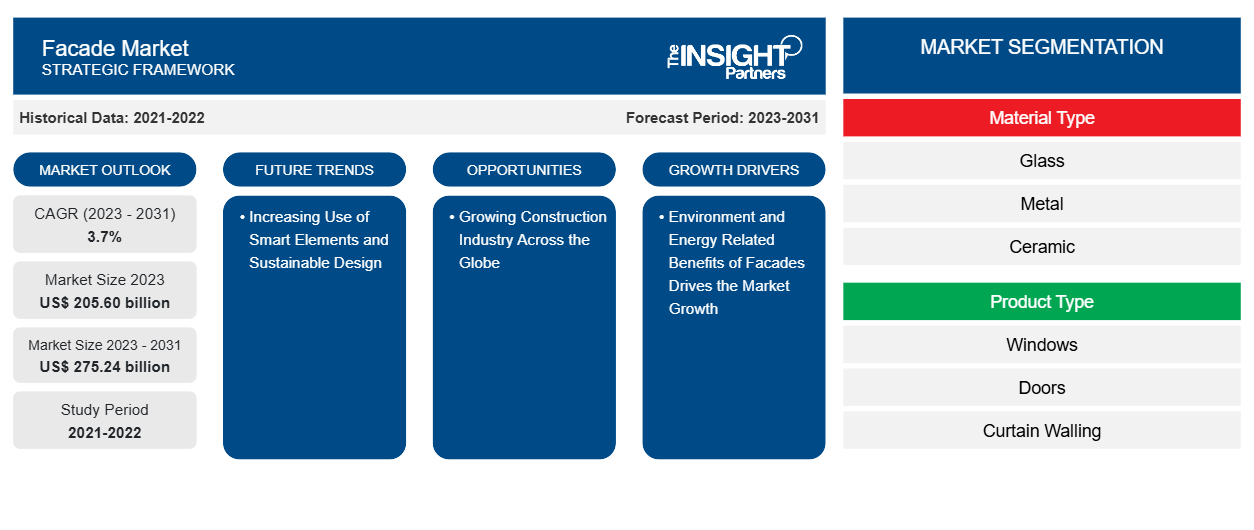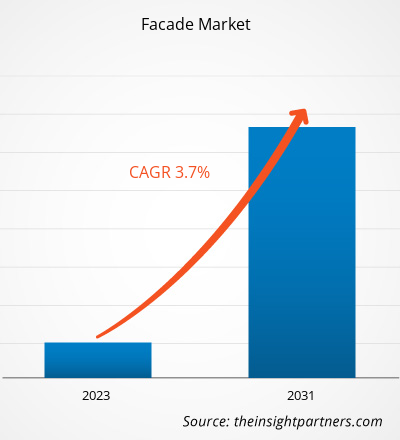外墙市场规模预计将从 2023 年的 2056 亿美元增至 2031 年的 2752.4 亿美元。预计 2023-2031 年期间,外墙市场的复合年增长率将达到 3.7%。全球建筑业的蓬勃发展很可能仍是外墙市场的主要趋势。
外墙市场分析
建筑行业的智能建筑设计与可持续性密切相关。将智能元素应用于即将建成的外墙包括选择和测试不同的技术,以提高外墙系统的质量和能力。此外,还采用了先进技术,通过增加建筑的价值和功能来增强外墙。如果外墙能够适应环境条件并相应地进行改造,则可将其归为智能外墙,这取决于组件对建筑物内外不同条件的适应性和适应性。智能外墙还包括智能玻璃,以最大限度地利用阳光,同时保护其免受太阳辐射,并在需要时同时控制通风和供暖。
外墙市场概览
在政府的大力支持和绿色建筑建设趋势的推动下,建筑业蓬勃发展,这些因素正在影响基础设施项目,推动外墙市场的增长。此外,先进绝缘材料、未增塑聚氯乙烯 (UPVC) 和双层外墙的渗透率高于其他材料,因为它提高了建筑的能源效率。此外,随着外墙预制外墙板等先进技术的出现,预计未来几年建筑业将实现增长。
根据材料,全球外墙市场分为玻璃、金属、陶瓷、木材和其他。金属部分进一步分为铝、铜、钢和其他。由于在商业应用中的采用越来越多,金属部分在 2023 年占据了最大的市场份额。根据应用,市场分为住宅、商业和工业。商业部分在 2023 年占据了市场份额的主导地位,因为外墙是一种用于改善美观的传统建筑系统。
定制此报告以满足您的需求
您可以免费定制任何报告,包括本报告的部分内容、国家级分析、Excel 数据包,以及为初创企业和大学提供优惠和折扣
- 获取此报告的关键市场趋势。这个免费样品将包括数据分析,从市场趋势到估计和预测。
外墙市场驱动因素和机遇
外墙的环境和能源相关效益推动市场增长
建筑立面系统是结构整体设计中最重要的组成部分之一,可为建筑增添独特特色。立面可保护建筑免受强风和暴雨造成的损害,并保护建筑免受极端温度和湿度的影响。它还可以防止紫外线穿透并提供自然通风。屋顶、墙壁、门窗等立面系统的组件控制空气的流入和流出,在减少灰尘和其他空气传播颗粒进入建筑物方面发挥着关键作用。通过智能连接建筑物的外部和内部,立面有助于控制光线穿透或过滤、热量调节和太阳能增益最小化,从而打造具有更高遮阳和被动冷却水平的节能建筑。
根据联合国环境规划署的数据,每年,建筑物及其建造过程消耗全球 36% 以上的能源,并导致全球约 40% 的温室气体排放。各主要参与者正在采用功能性外墙,包括幕墙,以积极影响能源效率,并具有很强的抗风雨、抗热、抗噪音、抗光和抗眩光能力。现代外墙的这些固有特性以及全球日益增长的环境和能源相关问题推动了全球外墙市场的增长。
基础设施开发项目投资不断增加
全球基础设施开发项目投资的不断增长推动了市场的增长,例如,2024 年 1 月,欧洲气候、环境和基础设施执行局收到了约 400 份申请,要求为交通基础设施项目提供 200 亿美元的资金。中国是世界上城市化率最高的国家之一。根据美国建筑师协会 (AIA) 上海分会的数据,预计到 2025 年,中国将建成相当于 10 个纽约大小的城市。根据国际贸易管理局 (ITA) 的数据,中国的“十四五”规划强调能源、交通、水系统和新型城镇化方面的新基础设施项目。
智能外墙设计使其更具互动性和灵活性。互动外墙设计具有广泛而多样的适应性和创新性,将为外墙市场在近期至中期的增长创造不断增长的空间。此外,人们正在投入大量研究和资金来开发先进的外墙系统,主要重点是玻璃系统和各种类型的墙壁。
外墙市场报告细分分析
有助于得出外墙市场分析的关键部分是材料、产品类型和应用。
- 根据材料,全球外墙市场分为玻璃、金属、陶瓷、木材等。金属领域的市场进一步细分为铝、铜、钢等。由于在商业应用中的采用越来越多,金属领域在 2023 年占据了最大的市场份额。
- 根据产品类型,外墙市场分为窗户、门、幕墙等。全球建筑行业正在经历显著增长。随着高层建筑和更大楼板的建设,最终用户正在寻求轻便、可重复使用、经济高效、耐用、灵活且易于组装和拆卸的先进模板系统。
- 根据应用,市场分为住宅、商业和工业。商业领域在 2023 年占据了市场份额的主导地位,因为外墙是建筑中用于改善美观的传统系统。
按地区划分的幕墙市场份额分析
外墙市场报告的地理范围主要分为五个地区:北美、亚太、欧洲、中东和非洲、南美和中美。
2023 年,亚太地区占据全球外墙市场的最大收入份额。由于城市化和工业化发展等因素,预计该地区在预测期内将在全球外墙市场中实现中等增长率。该地区人口众多,对商业和住宅建筑的需求很高。此外,东南亚的建筑活动正在大幅增长,预计将支持该地区外墙市场的增长。
外墙市场区域洞察
Insight Partners 的分析师已详尽解释了预测期内影响外墙市场的区域趋势和因素。本节还讨论了北美、欧洲、亚太地区、中东和非洲以及南美和中美洲的外墙市场细分和地理位置。

- 获取外墙市场的区域特定数据
外墙市场报告范围
| 报告属性 | 细节 |
|---|---|
| 2023 年的市场规模 | 2056亿美元 |
| 2031 年市场规模 | 2752.4亿美元 |
| 全球复合年增长率(2023 - 2031) | 3.7% |
| 史料 | 2021-2022 |
| 预测期 | 2023-2031 |
| 涵盖的领域 | 按材料类型
|
| 覆盖地区和国家 | 北美
|
| 市场领导者和主要公司简介 |
|
外墙市场参与者密度:了解其对业务动态的影响
外墙市场正在快速增长,这得益于最终用户需求的不断增长,这些需求源于消费者偏好的不断变化、技术进步以及对产品优势的认识不断提高等因素。随着需求的增加,企业正在扩大其产品范围,进行创新以满足消费者的需求,并利用新兴趋势,从而进一步推动市场增长。
市场参与者密度是指在特定市场或行业内运营的企业或公司的分布情况。它表明相对于给定市场空间的规模或总市场价值,有多少竞争对手(市场参与者)存在于该市场空间中。
在外墙市场运营的主要公司有:
- 兰博尔集团
- 林德纳公司
- Aluplex 印度私人有限公司
- Benson 幕墙(MiTek Industries, Inc.)
- 西勒管理有限公司
免责声明:上面列出的公司没有按照任何特定顺序排列。

- 获取外墙市场顶级关键参与者概述
外墙市场新闻及最新发展
通过收集一手和二手研究后的定性和定量数据来评估外墙市场,其中包括重要的公司出版物、协会数据和数据库。以下是外墙市场的发展情况:
- 圣戈班是轻型和可持续建筑领域的全球领导者,宣布与 Xynteo 创立的商业主导联盟“Build Ahead”建立合作关系。这家目标明确的咨询公司帮助世界上最大的组织发现对人类和地球有益的发展方式。该合作伙伴关系于 2024 年 2 月 15 日在新德里举行的联盟旗舰活动“The Exchange”上揭晓。(圣戈班 SA 公司网站,2024 年 2 月)
- 圣戈班玻璃将 ORAE 整合到其产品组合中。COOL-LITE XTREME ORAE 解决方案提供性能和可持续性,减少建筑物外墙的运营(使用建筑物时的冷却、加热和照明)和隐含碳。(圣戈班 SA 公司网站,2022 年)
外墙市场报告覆盖范围和交付成果
外墙市场报告覆盖范围和交付成果
“外墙市场规模和预测(2021-2031 年)”报告对以下领域进行了详细的市场分析:
- 范围内涵盖的所有主要细分市场的全球、区域和国家层面的外墙市场规模和预测
- 外墙市场趋势以及市场动态,如驱动因素、限制因素和关键机遇
- 详细的PEST分析和SWOT分析
- 外墙市场分析涵盖主要市场趋势、全球和区域框架、主要参与者、法规和最新市场发展
- 行业格局和竞争分析,涵盖市场集中度、热点图分析、知名参与者以及外墙市场的最新发展
- 详细的公司简介
- 历史分析(2 年)、基准年、预测(7 年)及复合年增长率
- PEST 和 SWOT 分析
- 市场规模价值/数量 - 全球、区域、国家
- 行业和竞争格局
- Excel 数据集


- 3D Mapping and Modelling Market
- Wheat Protein Market
- Rugged Phones Market
- Piling Machines Market
- Legal Case Management Software Market
- Social Employee Recognition System Market
- Rare Neurological Disease Treatment Market
- Advanced Planning and Scheduling Software Market
- Small Internal Combustion Engine Market
- Wire Harness Market

Report Coverage
Revenue forecast, Company Analysis, Industry landscape, Growth factors, and Trends

Segment Covered
This text is related
to segments covered.

Regional Scope
North America, Europe, Asia Pacific, Middle East & Africa, South & Central America

Country Scope
This text is related
to country scope.
常见问题
The market is expected to register a CAGR of 3.7% from 2023 to 2031.
The growing construction industry across the world is likely to remain key facade market trends during the forecast period.
Environment and energy-related benefits of facades drive the market growth. Also, rapid growth in infrastructure development projects across the globe drives market growth.
Asia Pacific dominated the market in 2023.
Ramboll Group A/S; Lindner AG; Aluplex India Pvt Ltd; Benson Curtain Wall (MiTek Industries, Inc.); seele verwaltungs GmbH; YFAÇADEFACADE PTE LTD; Compagnie de Saint-Gobain S.A.; Apogee Enterprises Inc.; Kingspan Group Plc; and Inovues, Inc. are among the key market players.
The facade market size is projected to reach US$ 275.24 billion by 2031 from US$ 205.60 billion in 2023.
Trends and growth analysis reports related to Manufacturing and Construction : READ MORE..
The List of Companies - Facade Market
- Ramboll Group A/S
- Lindner AG
- Aluplex India Pvt Ltd
- Benson Curtain Wall (MiTek Industries, Inc.)
- seele verwaltungs GmbH
- YFAÇADEFACADE PTE LTD
- Apogee Enterprises Inc.
- Kingspan Group Plc
- Inovues, Inc.
- Saint-Gobain S.A.
The Insight Partners performs research in 4 major stages: Data Collection & Secondary Research, Primary Research, Data Analysis and Data Triangulation & Final Review.
- Data Collection and Secondary Research:
As a market research and consulting firm operating from a decade, we have published and advised several client across the globe. First step for any study will start with an assessment of currently available data and insights from existing reports. Further, historical and current market information is collected from Investor Presentations, Annual Reports, SEC Filings, etc., and other information related to company’s performance and market positioning are gathered from Paid Databases (Factiva, Hoovers, and Reuters) and various other publications available in public domain.
Several associations trade associates, technical forums, institutes, societies and organization are accessed to gain technical as well as market related insights through their publications such as research papers, blogs and press releases related to the studies are referred to get cues about the market. Further, white papers, journals, magazines, and other news articles published in last 3 years are scrutinized and analyzed to understand the current market trends.
- Primary Research:
The primarily interview analysis comprise of data obtained from industry participants interview and answers to survey questions gathered by in-house primary team.
For primary research, interviews are conducted with industry experts/CEOs/Marketing Managers/VPs/Subject Matter Experts from both demand and supply side to get a 360-degree view of the market. The primary team conducts several interviews based on the complexity of the markets to understand the various market trends and dynamics which makes research more credible and precise.
A typical research interview fulfils the following functions:
- Provides first-hand information on the market size, market trends, growth trends, competitive landscape, and outlook
- Validates and strengthens in-house secondary research findings
- Develops the analysis team’s expertise and market understanding
Primary research involves email interactions and telephone interviews for each market, category, segment, and sub-segment across geographies. The participants who typically take part in such a process include, but are not limited to:
- Industry participants: VPs, business development managers, market intelligence managers and national sales managers
- Outside experts: Valuation experts, research analysts and key opinion leaders specializing in the electronics and semiconductor industry.
Below is the breakup of our primary respondents by company, designation, and region:

Once we receive the confirmation from primary research sources or primary respondents, we finalize the base year market estimation and forecast the data as per the macroeconomic and microeconomic factors assessed during data collection.
- Data Analysis:
Once data is validated through both secondary as well as primary respondents, we finalize the market estimations by hypothesis formulation and factor analysis at regional and country level.
- Macro-Economic Factor Analysis:
We analyse macroeconomic indicators such the gross domestic product (GDP), increase in the demand for goods and services across industries, technological advancement, regional economic growth, governmental policies, the influence of COVID-19, PEST analysis, and other aspects. This analysis aids in setting benchmarks for various nations/regions and approximating market splits. Additionally, the general trend of the aforementioned components aid in determining the market's development possibilities.
- Country Level Data:
Various factors that are especially aligned to the country are taken into account to determine the market size for a certain area and country, including the presence of vendors, such as headquarters and offices, the country's GDP, demand patterns, and industry growth. To comprehend the market dynamics for the nation, a number of growth variables, inhibitors, application areas, and current market trends are researched. The aforementioned elements aid in determining the country's overall market's growth potential.
- Company Profile:
The “Table of Contents” is formulated by listing and analyzing more than 25 - 30 companies operating in the market ecosystem across geographies. However, we profile only 10 companies as a standard practice in our syndicate reports. These 10 companies comprise leading, emerging, and regional players. Nonetheless, our analysis is not restricted to the 10 listed companies, we also analyze other companies present in the market to develop a holistic view and understand the prevailing trends. The “Company Profiles” section in the report covers key facts, business description, products & services, financial information, SWOT analysis, and key developments. The financial information presented is extracted from the annual reports and official documents of the publicly listed companies. Upon collecting the information for the sections of respective companies, we verify them via various primary sources and then compile the data in respective company profiles. The company level information helps us in deriving the base number as well as in forecasting the market size.
- Developing Base Number:
Aggregation of sales statistics (2020-2022) and macro-economic factor, and other secondary and primary research insights are utilized to arrive at base number and related market shares for 2022. The data gaps are identified in this step and relevant market data is analyzed, collected from paid primary interviews or databases. On finalizing the base year market size, forecasts are developed on the basis of macro-economic, industry and market growth factors and company level analysis.
- Data Triangulation and Final Review:
The market findings and base year market size calculations are validated from supply as well as demand side. Demand side validations are based on macro-economic factor analysis and benchmarks for respective regions and countries. In case of supply side validations, revenues of major companies are estimated (in case not available) based on industry benchmark, approximate number of employees, product portfolio, and primary interviews revenues are gathered. Further revenue from target product/service segment is assessed to avoid overshooting of market statistics. In case of heavy deviations between supply and demand side values, all thes steps are repeated to achieve synchronization.
We follow an iterative model, wherein we share our research findings with Subject Matter Experts (SME’s) and Key Opinion Leaders (KOLs) until consensus view of the market is not formulated – this model negates any drastic deviation in the opinions of experts. Only validated and universally acceptable research findings are quoted in our reports.
We have important check points that we use to validate our research findings – which we call – data triangulation, where we validate the information, we generate from secondary sources with primary interviews and then we re-validate with our internal data bases and Subject matter experts. This comprehensive model enables us to deliver high quality, reliable data in shortest possible time.


 获取此报告的免费样本
获取此报告的免费样本